Swayambhunath Temple stands proudly atop a hill in Kathmandu. This tabernacle holds deep spiritual value for Buddhists and Hindus likewise. Locals and excursionists frequently call it the Monkey Temple Nepal because of its lively monkey residers. Callers respect the tabernacle’s stunning armature and panoramic views of the megacity. The Swoyambhu Mahachaitya remains one of the oldest tabernacle in Nepal. It draws thousands of pilgrims and trippers every time. The tabernacle’s golden becket shines brightly under the sun. This blog will guide you through the prodigies of the Swoyambhu Mahachaitya.
The Swoyambhu Mahachaitya companion covers its rich history and artistic significance. Swayambhunath history dates back over two thousand times, making it a true heritage corner. The tabernacle features iconic prayer bus, statues, and ancient showpieces. People visit this point not only for deification but also for its serene atmosphere.

The major magnet of Swayambhunath tabernacle is its majestic stupa outgunned with the each- seeing eyes of Buddha. This tabernacle also holds a special place among UNESCO heritage spots Nepal. The UNESCO table helps cover its unique armature and spiritual value. You’ll discover numerous retired gems of monkey tabernacle within its complex.
Swoyambhu Mahachaitya combines natural beauty and deep church. The tabernacle overlooks Kathmandu valley, offering stirring views day and night. The retired gem of Kathmandu, this tabernacle welcomes all faiths with open arms. It represents the spirit of Buddhism and Nepalese culture in harmony. Data of Swayambhunath Nepal reveal why it remains a must- visit destination. This blog explores every corner of this sacred point with easy tips and fun data. Whether you come for history or peaceful vibes, Swayambhunath Temple won’t fail. Stay with us as we uncover the magic of this dateless wonder.
History and Origin of Swayambhunath Temple
The story of Swoyambhu Mahachaitya begins in more than 2,000 years ago. People believe the Kathmandu Valley was once a giant lake. A lotus flower bloomed right in the center of that lake. Over time, the lake dried up creating a hill where the flower stood. That hill became home and origin to the sacred Swayambhunath Temple. he word “Swayambhu” means “self-existent,” showing its natural and divine origin. Swayambhunath Temple reflects both legend and faith. It became one of the most spiritual places in Nepal.
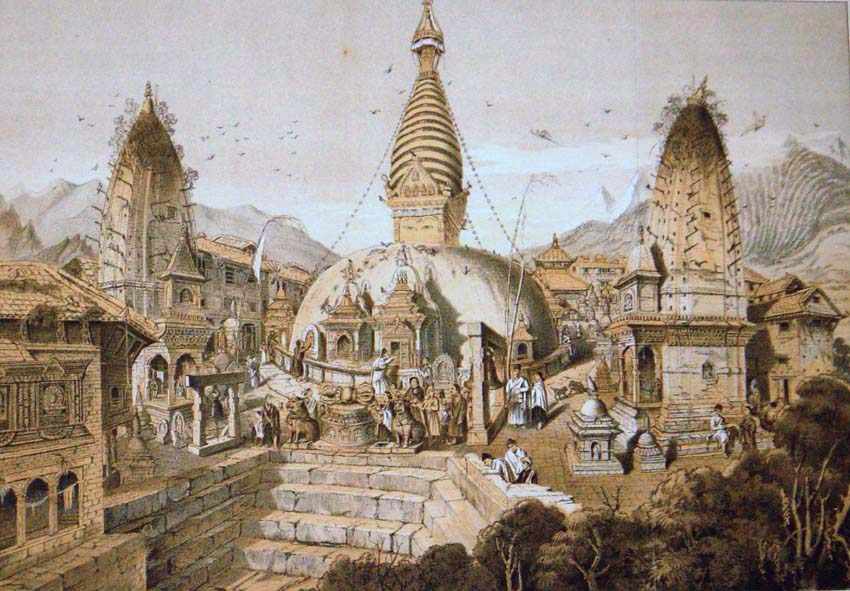
Historical records show the main stupa was built in the 5th century by King Manadeva. The structure has survived many earthquakes and changes over time. Different rulers added shrines, statues, and stairways to the site. Swayambhunath history shows strong ties and relationship to both Hindu and Buddhist cultures. The temple’s design includes symbols from both faiths. The eyes of Buddha on the stupa represent calmness, wisdom and peace. Devotees still walk around the stupa, spinning prayer wheels. This holy place stays active with rituals every day.
Swayambhunath Temple : Oldest Temple of Nepal
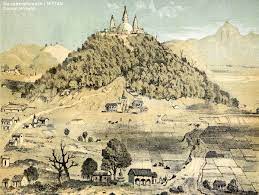
Swayambhunath Temple i.e Swoyambhu Mahachaitya is also known as the oldest temple in Nepal. Its long past and continued use make it a living monument. The temple earned its spot on the list of UNESCO heritage sites Nepal in 1979. That status helps protect its art, culture, and deep meaning. Monks, locals, and tourists visit throughout the year. The temple hill remains peaceful despite the city’s growth around it. This ancient site keeps its charm and power alive. The Swayambhunath Temple is one of the purest devotion towards Nepal’s History.
Location of Swayambhunath Temple
Swayambhunath Temple lies on a hilltop in the western part of Kathmandu, Nepal. The temple lies just 2.5 kilometers from the city center. You can reach it easily by taxi, bus, or a short hike. The hill offers a panoramic view of the entire Kathmandu Valley. The Swayambhunath Temple stands surrounded by trees, prayer flags, and ancient stone paths. Locals call the area a peaceful escape from the city noise. Nearby landmarks include Thamel, Durbar Square, and the Kathmandu Museum. This hill holds one of the most sacred spots in Nepal, the monkey temple.
Significance and Importance of Swayambhunath Temple
Swayambhunath Temple holds deep religious value for both Buddhists and Hindus. It represents wisdom, peace, and the eternal power of faith. numerous Buddhists believe the tabernacle was tone- created, making it a holy symbol of enlightenment. Hindus also visit the tabernacle to offer prayers and seek blessings. The tabernacle’s position on a hill symbolizes rising above worldly enterprises. Every element of the point holds meaning — from prayer bus to the each- seeing eyes of Buddha. The tabernacle continues to guide people on a spiritual path.
The Swayambhunath Temple is also the oldest tabernacle in Nepal. Its long-standing presence connects generations of worshippers and campaigners. The tabernacle has witnessed centuries of devotion, change, and growth. It stands strong as a memorial of Nepal’s spiritual roots.

Religious carnivals like Buddha Jayanti draw thousands to this sacred place. The tabernacle’s calm energy invites people from all walks of life. It shows the power of concinnity between different faiths.
Beyond religion, the tabernacle has artistic and public significance. Swayambhunath Temple appears on coins, oils, and indeed treatises in Nepal. It’s one of the most mugged places in the country. As one of the UNESCO heritage spots Nepal proudly preserves, it draws global attention. Excursionists visit to respect the views, art, and peaceful atmosphere. The tabernacle’s beauty and communication leave a continuing impact. It stands as a symbol of Nepalese identity and pride.
Major Attractions of Swayambhunath Temple
There are many reasons why Swoyambhu Mahachaitya is famous for. Some of the major attractions of Swoyambhu Mahachaitya is mentioned below so that you don’t missed out on it.
1. The Great Stupa
The large white pate of the stupa is the heart of Swayambhunath Temple. It represents the mind of Buddha and the trip to enlightenment. The stupa features the iconic painted eyes of Buddha, which watch over the Kathmandu Valley. These eyes emblematize mindfulness, compassion, and protection. Every pilgrim walks clockwise around the stupa while spinning prayer bus. This peaceful act shows deep respect and devotion. The stupa connects to both Buddhist and Hindu beliefs. It stands as a spiritual center for people of all faiths.
This stupa makes Swayambhunath Temple one of the most notorious religious spots in Asia. It shows the mix of art, belief, and ancient tradition. numerous people include it in every Swayambhunath Temple companion. As the oldest tabernacle in Nepal, its central stupa has lasted for centuries. The peaceful energy and architectural beauty draw thousands every time. Its spiritual power remains just as strong moment. This sacred monument is one reason why Swayambhunath is part of UNESCO heritage spots Nepal.

2. The All- Seeing Eyes of Buddha
The eyes of Buddha are painted on all four sides of the stupa palace. They remind people that wisdom and compassion must guide every action. A symbol suggesting a nose beneath the eyes actually represents the number one in Nepali. It stands for concinnity and the one path to enlightenment. These eyes watch over the entire Kathmandu Valley. They also attract artists, shutterbugs, and spiritual campaigners. numerous callers call them the most important part of Swayambhunath Temple. These eyes are also a top reason it’s known as the Monkey Temple Nepal.
This symbol has deep spiritual meaning. It reminds people to stay awake and aware in diurnal life. For numerous, seeing the eyes brings a feeling of peace and protection. The eyes appear in every print and card of the point. This makes them one of the major magnet of Swayambhunath Temple. No other tabernacle in Nepal has a point this iconic. That’s why people flash back these eyes long after they leave.
3. The Sacred Monkeys
Monkeys live freely around the Swayambhunath Temple complex. These creatures are sportful, curious, and considered sacred by numerous. People frequently bring fruit or snacks to feed them during visits. The monkeys have lived then for generations and are part of diurnal tabernacle life. Their presence gave rise to the surname Monkey Temple Nepal. numerous believe these monkeys guard the sacred grounds and keep bad spirits down. Watching them brings grins and joy to callers of all periods. They make the tabernacle feel alive and natural.
The monkeys are further than just creatures then. They’re part of the tabernacle’s charm and culture. Seeing monkeys interact with monks and pilgrims is a unique experience. The tabernacle treats them with respect, and locals believe they carry good luck. For shutterbugs and nature suckers, the monkeys offer great print moments. This adds another subcaste to the retired gem of Monkey Temple. They make your visit fun, sacred, and memorable.
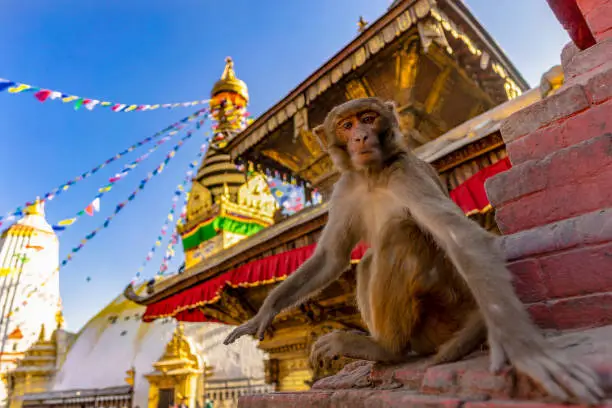
4. Prayer Wheels and Small Sanctuaries
Prayer bus line the paths that compass the main stupa. Each wheel has mantras written in ancient script. Pilgrims spin the bus as they walk clockwise, transferring out prayers with every turn. This act brings peace, focus, and spiritual clarity. The sound of spinning bus adds to the calm tabernacle atmosphere. Small sanctuaries beside the bus honor gods, bodhisattvas, and original divinities. These spaces offer quiet moments for prayer and reflection. They also educate callers about the roots of Buddhism.
These rudiments are frequently stressed in every Swayambhunath Temple companion. They show how the tabernacle stays alive with diurnal spiritual exertion. Addicts light lights, offer flowers, and bow with folded hands. Excursionists also take part and feel a sense of calm. The prayer bus and sanctuaries are living symbols of faith. They bring people closer to the tabernacle’s deeper meaning. Together, they form the spiritual meter of this sacred point.
UNESCO Heritage Site Listing
Swayambhunath Temple earned its place among UNESCO heritage sites Nepal in 1979. The listing recognizes the temple’s ancient history, spiritual value, and unique design. This honor helps protect its art, culture, and religious traditions. Many people visit the site because of its global recognition. The temple stands as a symbol of Nepal’s rich cultural identity. UNESCO status adds worldwide importance to this sacred place.
The listing ensures that restoration and preservation efforts follow global standards. Experts work regularly to maintain the stupa, shrines, and surrounding structures. Tourists from around the world now explore the site with deeper respect. The temple’s status highlights it in every Swayambhunath Temple guide. Its spiritual beauty and historical depth now reach a global audience. This recognition helps future generations experience its sacred energy.
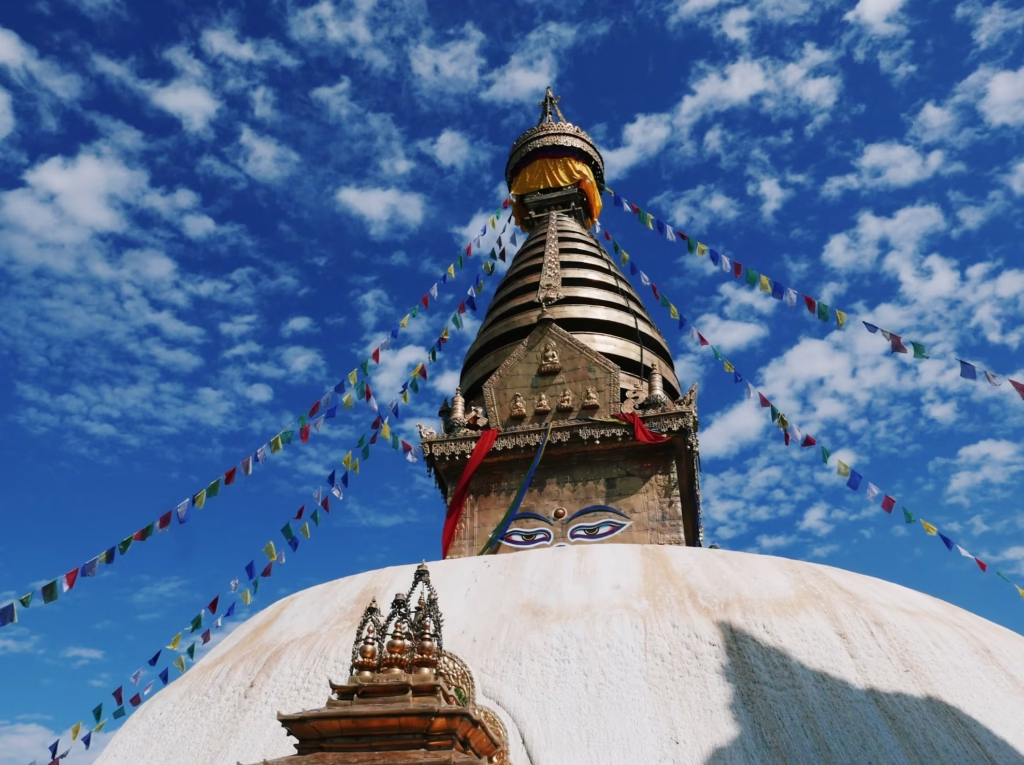
Top 10 Fun Facts of Swayambhunath Temple
Top 10 fun facts of Swayabhunath temple that you shouldn’t miss knowing.
1. The temple is over 2,000 years old.
Swayambhunath Temple is one of the oldest religious sites in Nepal. It has stood strong for more than two millennia.
2. It was never fully “built”—it appeared.
Legends say the stupa rose from a lotus that bloomed in the middle of a lake. That’s why it means “self-created.”
3. Monkeys live here—and they rule.
The temple is called Monkey Temple Nepal because of the holy monkeys living all around the complex.
4. There are 365 steps to the top.
Pilgrims climb exactly 365 stone steps—one for each day of the year—to reach the stupa.
5. The Buddha’s eyes see everything.
The stupa has Buddha’s eyes painted on all four sides. They symbolize wisdom watching the world.
6. The nose is not a nose.
What looks like a nose below the eyes is actually the Nepali number one. It represents unity and the single path to truth.
7. It blends two religions.
Swayambhunath Temple brings Hindu and Buddhist traditions together. Both groups worship here with equal devotion.
8. It offers the best city view.
From the top, you can see the entire Kathmandu Valley. Sunset views here are truly magical.
9. It’s full of hidden symbols.
Every corner of the temple has secret meanings—from the prayer wheels to small shrines. These signs reflect deep Buddhist teachings.
10. It’s a UNESCO gem.
The temple was listed as one of the UNESCO heritage sites Nepal in 1979. That makes it globally protected and recognized.
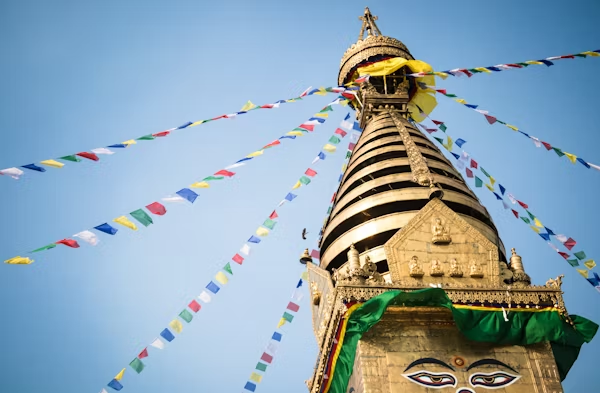
Documents and cost requirements to visit Swayambhunath Temple
| Nationality/Region | Entry Fee (Approx.) | Documents Required |
|---|---|---|
| Nepali Citizens | Free | No documents needed for entry |
| Indian Citizens | Free | ID proof (Aadhaar card, passport, or voter ID) |
| Chinese Citizens | NPR 200 | Valid passport and visa |
| SAARC Nationals | NPR 200 | Valid passport (visa on arrival for most) |
| European Nationals | NPR 300 | Passport and tourist visa |
| Other Asian Nationals | NPR 300 | Passport and visa |
| Australian Nationals | NPR 300 | Passport and tourist visa |
| African Nationals | NPR 300 | Passport and tourist visa |
Final Thoughts
Swayambhunath Temple stands as a symbol of peace, history, and deep spiritual value. It welcomes people from all over the world every day. The sacred hill offers stunning views and a quiet escape from the city. As the one of the oldest temple in Nepal, it holds great importance in both Buddhism and Hinduism. From prayer wheels to sacred monkeys, every corner tells a story. The experience here stays with you long after your visit.
Its status as one of the UNESCO heritage sites Nepal proves its cultural and global worth. This complete Swayambhunath Temple guide helps you explore every part with ease. You can feel the temple’s power through its symbols, sounds, and calm energy. The site blends tradition, faith, and beauty in a unique way. Whether you seek peace or discovery, the Monkey Temple Nepal offers both. Let this journey add something meaningful to your life.

